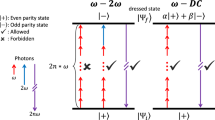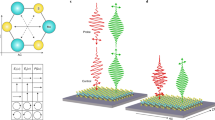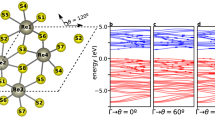Abstract
High-harmonic generation (HHG) is a signature optical phenomenon of strongly driven, nonlinear optical systems. Specifically, the understanding of the HHG process in rare gases has played a key role in the development of attosecond science1. Recently, HHG has also been reported in solids, providing novel opportunities such as controlling strong-field and attosecond processes in dense optical media down to the nanoscale2. Here, we report HHG from a low-loss, indium-doped cadmium oxide thin film by leveraging the epsilon-near-zero (ENZ) effect3,4,5,6,7,8, whereby the real part of the material’s permittivity in certain spectral ranges vanishes, as well as the associated large resonant enhancement of the driving laser field. We find that ENZ-assisted harmonics exhibit a pronounced spectral redshift as well as linewidth broadening, resulting from the photo induced electron heating and the consequent time-dependent ENZ wavelength of the material. Our results provide a new platform to study strong-field and ultrafast electron dynamics in ENZ materials, reveal new degrees of freedom for spectral and temporal control of HHG, and open up the possibilities of compact solid-state attosecond light sources.
This is a preview of subscription content, access via your institution
Access options
Access Nature and 54 other Nature Portfolio journals
Get Nature+, our best-value online-access subscription
$29.99 / 30 days
cancel any time
Subscribe to this journal
Receive 12 print issues and online access
$209.00 per year
only $17.42 per issue
Buy this article
- Purchase on Springer Link
- Instant access to full article PDF
Prices may be subject to local taxes which are calculated during checkout




Similar content being viewed by others
Data availability
The data that support the plots within this paper and other findings of this study are available from the corresponding authors on reasonable request.
References
Krausz, F. & Ivanov, M. Attosecond physics. Rev. Mod. Phys. 81, 163–234 (2009).
Ghimire, S. & Reis, D. A. High-harmonic generation from solids. Nat. Phys. 15, 10–16 (2019).
Alam, M. Z., De Leon, I. & Boyd, R. W. Large optical nonlinearity of indium tin oxide in its epsilon-near-zero region. Science 352, 795–797 (2016).
Caspani, L. et al. Enhanced nonlinear refractive index in epsilon-near-zero materials. Phys. Rev. Lett. 116, 233901 (2016).
Engheta, N. Pursuing near-zero response. Science 340, 286–287 (2013).
Luk, T. S. et al. Enhanced third harmonic generation from the epsilon-near-zero modes of ultrathin films. Appl. Phys. Lett. 106, 151103 (2015).
Niu, X., Hu, X., Chu, S. & Gong, Q. Epsilon-near-zero photonics: a new platform for integrated devices. Adv. Opt. Mater. 6, 1701292 (2018).
Yang, Y. et al. Femtosecond optical polarization switching using a cadmium oxide-based perfect absorber. Nat. Photon. 11, 390–395 (2017).
McPherson, A. et al. Studies of multiphoton production of vacuum-ultraviolet radiation in the rare gases. J. Opt. Soc. Am. B 4, 595–601 (1987).
Luu, T. T. et al. Extreme ultraviolet high-harmonic spectroscopy of solids. Nature 521, 498–502 (2015).
Ghimire, S. et al. Observation of high-order harmonic generation in a bulk crystal. Nat. Phys. 7, 138–141 (2010).
Sivis, M. et al. Tailored semiconductors for high-harmonic optoelectronics. Science 357, 303–306 (2017).
Liu, H. et al. Enhanced high-harmonic generation from an all-dielectric metasurface. Nat. Phys. 14, 1006–1010 (2018).
Liu, H. et al. High-harmonic generation from an atomically thin semiconductor. Nat. Phys. 13, 262–265 (2017).
Hafez, H. A. et al. Extremely efficient terahertz high-harmonic generation in graphene by hot Dirac fermions. Nature 561, 507–511 (2018).
Garg, M., Kim, H. Y. & Goulielmakis, E. Ultimate waveform reproducibility of extreme-ultraviolet pulses by high-harmonic generation in quartz. Nat. Photon. 12, 291–296 (2018).
Ghimire, S. et al. Generation and propagation of high-order harmonics in crystals. Phys. Rev. A 85, 043836 (2012).
Han, S. et al. High-harmonic generation by field enhanced femtosecond pulses in metal–sapphire nanostructure. Nat. Commun. 7, 13105 (2016).
Vampa, G. et al. Plasmon-enhanced high-harmonic generation from silicon. Nat. Phys. 13, 659–662 (2017).
Sachet, E. et al. Dysprosium-doped cadmium oxide as a gateway material for mid-infrared plasmonics. Nat. Mater. 14, 414–420 (2015).
Kelley, K. P., Sachet, E., Shelton, C. T. & Maria, J. P. High mobility yttrium doped cadmium oxide thin films. APL Mater. 5, 076105 (2017).
Naik, G. V., Kim, J. & Boltasseva, A. Oxides and nitrides as alternative plasmonic materials in the optical range. Opt. Mater. Express 1, 1090–1099 (2011).
Stern, E. A. & Ferrell, R. A. Surface plasma oscillations of a degenerate electron gas. Phys. Rev. 120, 130–136 (1960).
Berreman, D. W. Infrared absorption at longitudinal optic frequency in cubic crystal films. Phys. Rev. 130, 2193–2198 (1963).
Campione, S., Brener, I. & Marquier, F. Theory of epsilon-near-zero modes in ultrathin films. Phys. Rev. B 91, 121408 (2015).
Cimino, A. & Marezio, M. Lattice parameter and defect structure of cadmium oxide containing foreign atoms. J. Phys. Chem. Solids 17, 57–64 (1960).
Guo, P., Schaller, R. D., Ketterson, J. B. & Chang, R. P. H. Ultrafast switching of tunable infrared plasmons in indium tin oxide nanorod arrays with large absolute amplitude. Nat. Photon. 10, 267–273 (2016).
Kane, E. O. Band structure of indium antimonide. J. Phys. Chem. Solids 1, 249–261 (1957).
Turchinovich, D., Hvam, J. M. & Hoffmann, M. C. Self-phase modulation of a single-cycle terahertz pulse by nonlinear free-carrier response in a semiconductor. Phys. Rev. B 85, 201304 (2012).
Wood, M. G. et al. Gigahertz speed operation of epsilon-near-zero silicon photonic modulators. Optica 5, 233–236 (2018).
Acknowledgements
This work started when Y.Y. was a postdoctoral researcher at Sandia National Laboratories. The work performed at Sandia National Laboratories was supported by the US Department of Energy (DOE), Office of Basic Energy Sciences, Division of Materials Sciences and Engineering, and performed, in part, at the Center for Integrated Nanotechnologies, an Office of Science User Facility operated for the US DOE Office of Science. Sandia National Laboratories is a multi-mission laboratory managed and operated by National Technology and Engineering Solutions of Sandia, a wholly owned subsidiary of Honeywell International, for the US DOE’s National Nuclear Security Administration under contract DE-NA-0003525. The views expressed in this article do not necessarily represent the views of the US DOE or the United States Government. The work performed at SLAC was primarily supported by the US DOE, Office of Science, Basic Energy Sciences, Chemical Sciences, Geosciences and Biosciences Division through the Early Career Research Program. Y.Y. acknowledges support from the Youth Thousand Talent program of China. A.M. acknowledges the National Science Foundation (grant ECCS-1710697) and the UNM Center for Advanced Research Computing for providing high-performance computing resources. J.-P.M. acknowledges support from the National Science Foundation (grant CHE-1507947) and Army Research Office (grants W911NF16-1-0406 and W911NF-16-1-0037). S.G. thanks U. Thumm for stimulating discussions.
Author information
Authors and Affiliations
Contributions
Y.Y. conceived the idea. J.L., Y.Y., T.S.L. and H.L. carried out optical measurements. A.M. developed the theory. K.K., J.-P.M. and E.L.R. prepared the sample. All authors contributed to analysing the data and writing the manuscript. I.B., S.G., M.B.S. and J.-P.M. supervised the project.
Corresponding authors
Ethics declarations
Competing interests
The authors declare no competing interests.
Additional information
Peer review information: Nature Physics thanks Dmitry Turchinovich and the other, anonymous, reviewer(s) for their contribution to the peer review of this work.
Publisher’s note: Springer Nature remains neutral with regard to jurisdictional claims in published maps and institutional affiliations.
Supplementary information
Supplementary Information
Supplementary figures and notes.
Rights and permissions
About this article
Cite this article
Yang, Y., Lu, J., Manjavacas, A. et al. High-harmonic generation from an epsilon-near-zero material. Nat. Phys. 15, 1022–1026 (2019). https://doi.org/10.1038/s41567-019-0584-7
Received:
Accepted:
Published:
Issue Date:
DOI: https://doi.org/10.1038/s41567-019-0584-7
This article is cited by
-
Momentum-dependent intraband high harmonic generation in a photodoped indirect semiconductor
Communications Physics (2024)
-
Thermo-optic epsilon-near-zero effects
Nature Communications (2024)
-
Nanoscale modeling of dynamically tunable planar optical absorbers utilizing InAs and InSb in metal-oxide-semiconductor–metal configurations
Discover Nano (2023)
-
High-harmonic generation in CdTe with ultra-low pump intensity and high photon flux
Communications Physics (2023)
-
Engineering the temporal dynamics of all-optical switching with fast and slow materials
Nature Communications (2023)



